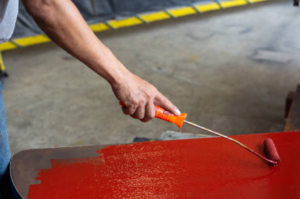What Are Solvent-Based Coatings?
Solvent-based coatings are a type of paint or finish that relies on organic solvents as a carrier for the coating materials. These coatings consist of a mixture of resins, pigments, solvents, and additives, which collectively contribute to their properties and performance. When the solvent evaporates, it allows the resin and pigment to form a solid film that adheres to the surface. This mechanism is distinct from water-based coatings, which utilize water as the primary solvent and generally have lower levels of volatile organic compounds (VOCs).
The composition of solvent-based coatings typically includes alkyd, epoxy, or polyurethane resins that provide durability, adhesion, and resistance to environmental degradation. Alkyd resins are often used for their excellent flow and leveling properties, while epoxy resins are recognized for their remarkable chemical resistance and hardness. Polyurethane coatings, on the other hand, are favored for their flexibility and resistance to abrasion and UV damage. Such chemical characteristics make solvent-based coatings versatile and widely applicable in various sectors, including automotive, industrial, and architectural finishes.
Common solvents utilized in these formulations include toluene, xylene, and mineral spirits. These organic solvents are integral in dissolving the resin and ensuring uniformity within the coating. However, the use of solvent-based coatings has come under scrutiny due to their potential environmental impact, including the release of VOCs during application and drying. Consequently, manufacturers and regulators are increasingly focusing on reducing VOC levels and promoting eco-friendlier alternatives while still preserving the performance characteristics of solvent-based products without compromising quality.

Advantages of Solvent-Based Coatings
Solvent-based coatings offer a range of advantages that make them a preferred choice in various industries, from automotive to architectural applications. One of the most notable benefits is their durability. These coatings create a robust protective layer that can withstand harsh environmental conditions, including exposure to chemicals, moisture, and UV radiation. This characteristic ensures that surfaces remain intact over time, thus reducing the frequency of maintenance and repainting.
Another significant advantage of solvent-based coatings is their gloss retention. Unlike some water-based alternatives, solvent formulations maintain their sheen and aesthetic appeal for extended periods. This visual quality not only enhances the overall look of a project but also contributes to its longevity. The glossy finish helps in resisting dirt and grime, making these coatings ideal for surfaces that endure high levels of traffic or exposure.
Rapid drying properties are yet another key benefit of solvent-based coatings. They typically cure faster than water-based options, allowing for quicker project completion and minimizing downtime. This characteristic is especially essential in industrial settings where operational efficiency is crucial. As a result, contractors and facility managers can apply these coatings in a timely manner, maintaining productivity without compromising on quality.
Furthermore, solvent-based coatings demonstrate excellent adhesion capabilities. This means they bond effectively with various substrates, ensuring strong, lasting applications. The ability to adhere well is critical in industries like automotive manufacturing, where coatings must withstand mechanical stress and environmental factors.
In conclusion, the advantages of solvent-based coatings, including durability, gloss retention, rapid drying properties, and excellent adhesion, make them a valuable option in numerous applications. Their benefits signify a strategic choice for various industries, ultimately enhancing the lifespan and appearance of coated surfaces.
Disadvantages and Environmental Concerns
Solvent-based coatings, despite their widespread use and advantageous properties, harbor several disadvantages and environmental concerns that warrant serious consideration. One of the most significant issues associated with these coatings is the emission of volatile organic compounds (VOCs). These organic solvents evaporate into the atmosphere during application and drying, contributing to air pollution. VOCs are known to form ground-level ozone and smog, both of which pose serious health risks to humans and can exacerbate existing respiratory conditions.
In addition to the environmental implications, solvent-based coatings also present potential health hazards to those who work with them. Exposure to high levels of VOCs can lead to a variety of health issues, including headaches, dizziness, and respiratory problems. Long-term exposure has been linked to more severe ailments, including liver damage and central nervous system effects. Consequently, the safety measures required when handling these products often entail the use of personal protective equipment (PPE), thereby increasing operational costs and complicating the application process.
Furthermore, regulatory frameworks are evolving to address these environmental and health concerns. Governments worldwide are implementing stricter regulations regarding VOC emissions, pushing manufacturers to adapt their formulations and processes. This shift highlights the rising trend toward eco-friendly alternatives, such as water-based or low-VOC coatings, which aim to minimize harmful impacts while still achieving high performance. The transition to more sustainable options is being fueled by consumer demand for greener products, reinforcing the need for manufacturers to innovate. As the industry moves forward, it is essential to weigh the benefits of solvent-based coatings against their environmental repercussions and to embrace emerging technologies that promote safety and sustainability.
Applications of Solvent-Based Coatings
Solvent-based coatings have established themselves as a vital component across numerous industries due to their exceptional performance attributes and versatility. One of the most prominent applications of these coatings is in automotive refinishing. The automotive sector frequently employs solvent-based paints and varnishes because they provide a durable, high-gloss finish that can withstand the rigors of weather exposure and mechanical wear. These coatings dry relatively quickly and allow for easier manipulation during the refinishing process, ensuring a professional appearance on vehicles.
In the manufacturing industry, solvent-based coatings are frequently used to protect metals and other materials from corrosion and wear. These coatings form a robust protective layer that enhances the longevity of machinery and metal components. For instance, industrial equipment often benefits from solvent-based coatings designed for high-performance applications, capable of withstanding extreme temperatures and aggressive chemicals.
Wood finishing is another significant application for solvent-based coatings. Whether in residential or commercial settings, these coatings are commonly utilized to enhance the natural beauty of wood while also providing a protective barrier against scratches, stains, and moisture. The fast-drying properties make them an attractive choice for furniture and cabinetry, where a smooth, appealing finish is essential.
A further noteworthy application is in protective coatings for various substrates, including metals, plastics, and concrete. These coatings are formulated to offer resistance to abrasion, chemicals, and environmental stressors, making them suitable for construction and industrial applications. From bridges to pipelines, solvent-based coatings play a critical role in safeguarding structures and extending their service life.
Overall, solvent-based coatings cater to a wide array of functional requirements across multiple sectors, exemplifying their adaptability and effectiveness in both everyday and specialized applications.
Application Techniques for Solvent-Based Coatings
When applying solvent-based coatings, multiple techniques can be employed, each offering unique advantages depending on the project requirements. The most common methods include spraying, brushing, and rolling. Understanding these techniques and their best practices can help ensure a successful application, providing a durable and aesthetically pleasing finish.
Spraying is a popular method due to its efficiency and even coverage. This technique is particularly suitable for large surfaces or intricate designs where precision is essential. Before spraying, it is crucial to prepare the surface by cleaning it thoroughly and addressing any imperfections. Additionally, manufacturers often recommend specific spray equipment settings to achieve optimal results, ensuring that the coating is applied in a consistent manner. Proper ventilation is also vital during this process, as solvent-based coatings can emit harmful vapors.
Brushing is another effective technique, particularly for smaller surfaces or areas requiring detailed work. This method allows for greater control, making it ideal for intricate designs or edges. To achieve a smooth finish, it is essential to use high-quality brushes designed for solvent-based coatings. The surface should be prepared similarly to other methods, ensuring that it is clean and free of debris. When brushing, applying the coating in thin, even layers is recommended to prevent drips and runs.
Rolling is an effective approach for covering larger, flat surfaces efficiently. Similar to spraying, rolling allows for quick application but requires careful attention to the roller cover material selected. Optimal surface preparation, as in other techniques, plays a significant role in the overall outcome. It is advisable to work in sections and use a consistent rolling motion to achieve uniform coating thickness.
In each of these application techniques, following manufacturer instructions is critical to achieving the best results. By adhering to preparation steps and application tips, one can enhance the effectiveness of solvent-based coatings, ensuring durability and performance for the intended use.

Comparison with Water-Based Coatings
When evaluating coating options, solvent-based coatings and water-based coatings stand out as two prominent categories, each possessing distinct characteristics. One of the critical factors that differentiate these two types is drying time. Solvent-based coatings typically exhibit faster drying capabilities than their water-based counterparts. The volatile organic compounds (VOCs) in solvent-based products evaporate quickly, allowing for rapid application and recoat times. Conversely, water-based coatings may take longer to dry due to their higher water content, which can slow down the evaporation process, influencing project timelines and productivity.
Adhesion properties are another essential consideration in the comparison between the two types of coatings. Solvent-based coatings often provide superior adhesion on a wider variety of surfaces, including metal and plastic, making them suitable for demanding applications. On the other hand, water-based coatings may require specific surface preparations to achieve optimal adhesion, which can add steps to the overall application process.
Durability of the coatings is a significant factor as well. Solvent-based options tend to offer outstanding durability and resistance to wear, chemicals, and environmental factors, making them an excellent choice for high-traffic areas or harsh conditions. However, advances in water-based technology have improved their durability too, enabling them to perform adequately in many applications, albeit typically not to the same extent as solvent-based products.
Environmental impact also plays a crucial role in the assessment of these coatings. Solvent-based coatings contain VOCs, which can contribute to air pollution and health concerns, whereas water-based coatings are generally considered more environmentally friendly due to their lower VOC levels. Choosing between solvent-based and water-based coatings ultimately hinges on specific project requirements, including environmental considerations, as well as factors such as application method and surface type.

Health and Safety Considerations
As the use of solvent-based coatings becomes prevalent in various industries, understanding the associated health and safety considerations is critical. Solvent-based coatings contain volatile organic compounds (VOCs) that can pose health risks to individuals during application and throughout the lifecycle of the product. It is essential to implement appropriate safety measures to mitigate these risks effectively.
One of the primary precautions involves the use of personal protective equipment (PPE). Workers should wear suitable PPE, including gloves, goggles, and respirators, to minimize exposure to harmful chemicals present in solvent-based coatings. Selecting the right type of gloves and respirators is crucial, as not all are effective against specific solvents. Therefore, assessing the material safety data sheet (MSDS) for product-specific recommendations is advisable.
Moreover, ensuring proper ventilation in the workspace is vital while using solvent-based coatings. Adequate ventilation helps disperse potentially harmful vapors and reduces the risk of inhalation. Open windows, use of exhaust fans, and working in well-ventilated areas are effective strategies to improve air circulation. In some scenarios, using a ventilated spray booth may be necessary, especially for large-scale applications, as it can offer additional control over airborne contaminants.
Safe handling and disposal practices are also essential components of health and safety management when working with solvent-based coatings. This includes properly storing coatings in tightly sealed containers, labeling them correctly to avoid confusion, and disposing of unused products and their containers in accordance with local regulations. By adhering to these practices, individuals can significantly lessen the adverse health impacts associated with solvent-based coatings.
Future Trends in Coating Technologies
The coatings industry is undergoing significant transformation, particularly with a growing emphasis on sustainability and eco-friendliness. As environmental concerns continue to rise, manufacturers are increasingly prioritizing the development of low-VOC (Volatile Organic Compounds) and eco-friendly solvent-based coatings. Innovations in this area are not only meeting regulatory standards but are also appealing to a broader audience that is becoming more eco-conscious.
In recent years, research and development initiatives have played a crucial role in enhancing the performance of solvent-based coatings while minimizing their environmental impact. This progress focuses on formulating products that maintain the durability and aesthetic qualities of traditional coatings, while also improving their application properties. These advancements are made possible through the integration of innovative raw materials and technologies, which aim to reduce harmful emissions without compromising quality.
Another notable trend is the increasing interest in bio-based solvent systems. These alternatives are derived from renewable resources, positioning them as advantageous substitutes to conventional solvent-based products. The utilization of natural materials not only supports sustainability goals but also enhances the marketability of coatings to industries that prioritize health and environmental safety.
Market predictions indicate that the shift towards low-VOC and eco-friendly coatings will continue to gain momentum, driven by stringent environmental regulations and rising consumer demands. This trend is expected to foster the growth of a more sustainable coatings market, challenging manufacturers to innovate continuously. Sustainability, combined with a focus on enhanced performance, will remain at the forefront of industry strategies.
In conclusion, as the coatings industry evolves, the emphasis on eco-friendly practices and innovative technologies will reshape market dynamics, paving the way for more sustainable solvent-based coatings in the future.

Conclusion: The Role of Solvent-Based Coatings in Modern Industry
Solvent-based coatings continue to play a significant role in various sectors of modern industry. Their unique chemical properties provide manufacturers with the ability to produce durable, high-performance finishes that enhance product appearance and longevity. These coatings are widely utilized across industries including automotive, aerospace, and construction, due to their excellent adhesion, smooth application, and impressive resistance to environmental factors such as moisture, UV radiation, and chemicals. The robust nature of solvent-based coatings makes them a preferred choice for high-demand applications.
Despite their benefits, there are challenges associated with the use of solvent-based coatings. Environmental regulations regarding volatile organic compounds (VOCs) have prompted manufacturers to develop formulations that are less harmful to both human health and the environment. As a result, many companies are now exploring alternatives such as water-based coatings or low-VOC solvent-based options. This transition underscores the industry’s commitment to sustainability while still acknowledging the essential features that solvent-based coatings offer.
The future trends in the realm of solvent-based coatings are moving towards innovative technologies and enhanced functionalities. Developments in nanotechnology and smart coatings suggest a promising horizon, wherein coatings not only serve traditional protective roles but also offer features like self-cleaning and self-repairing capabilities. Such advancements will likely bolster the position of solvent-based coatings in an ever-evolving market. As the need for durable and reliable coatings persists, it is crucial for industry professionals to stay informed about ongoing research and technological progress.
In summary, solvent-based coatings remain a vital component in the contemporary industrial landscape. Their ability to deliver superior performance and durability across various applications highlights their importance. As the industry adapts to environmental challenges and embraces future innovations, the role of solvent-based coatings is poised to continue evolving, reinforcing their relevance in modern manufacturing processes.

